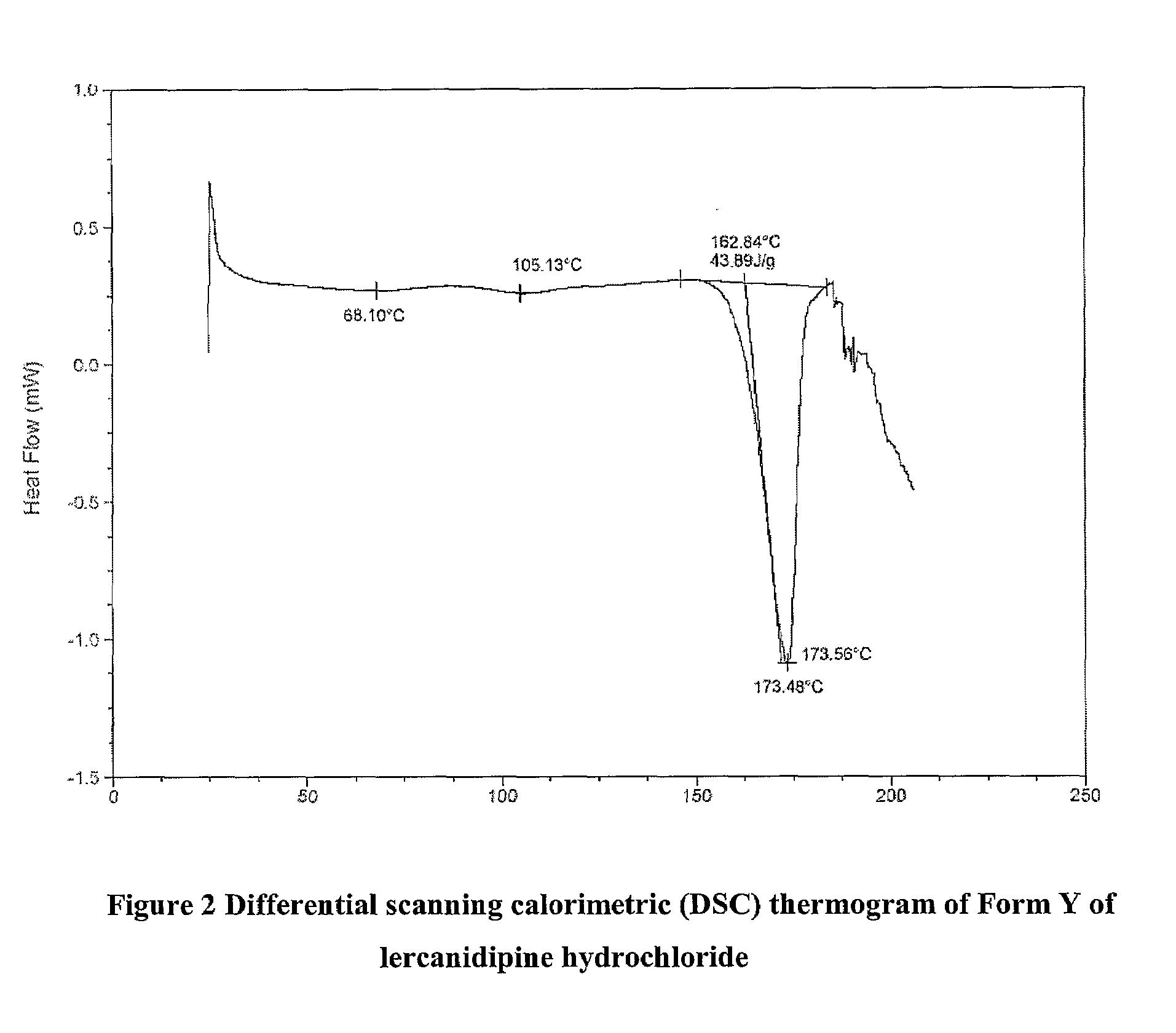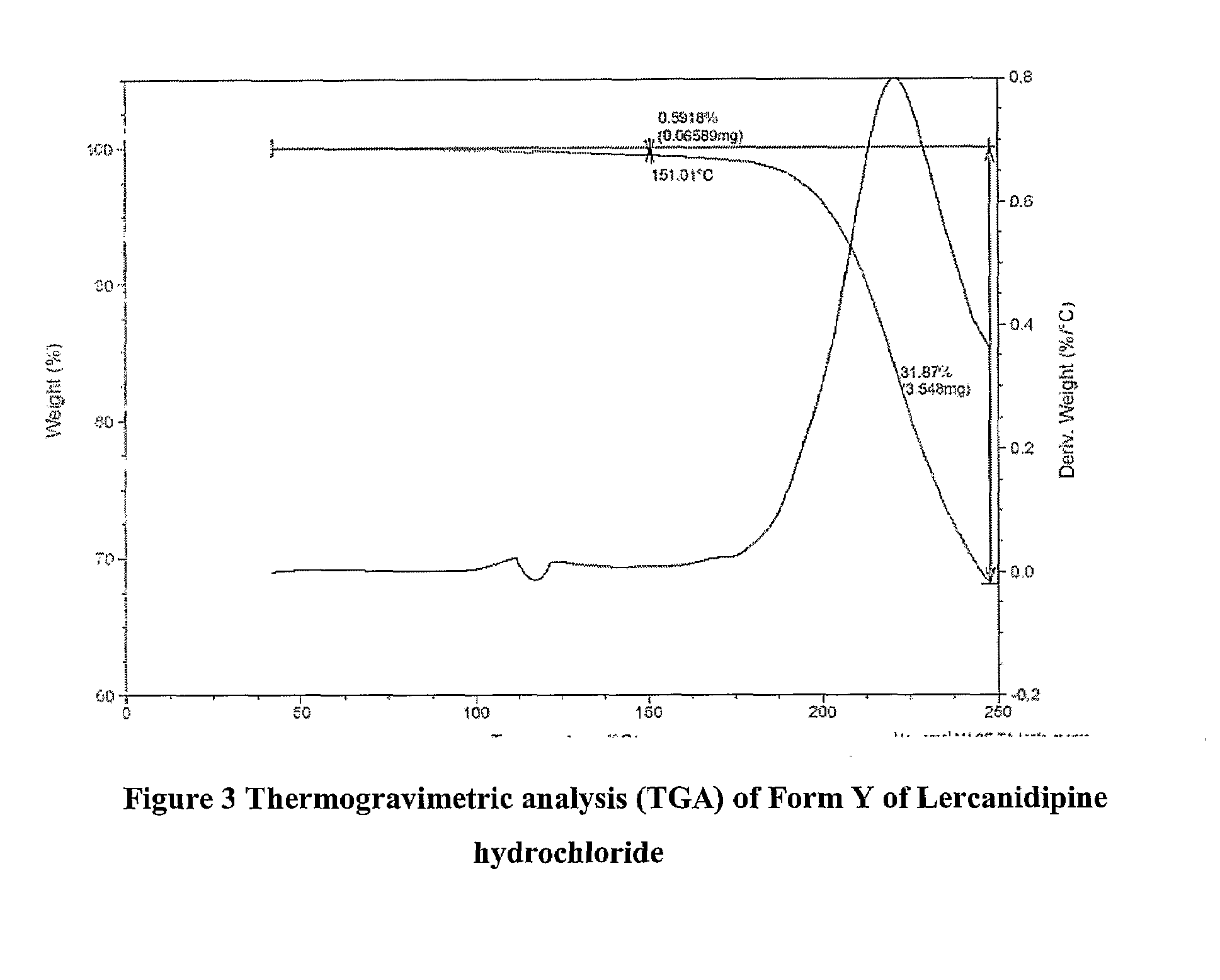Lercanidipine Hydrochloride Polymorphs and an Improved Process for Preparation of 1,1,N-Trimethyl-N-(3,3-Diphenylpropyl)-2-Aminoethyl Acetoacetate
a technology of n-trimethyln-propyl and n-trimethyln-(3,3-diphenylpropyl)-2-aminoethyl acetoacetate, which is applied in the field of lercanidipine hydrochloride polymorphs and an improved process for the preparation of 1, 1, n-trimethyln-(3,3-diphenylpropyl)-2-aminoethyl acetoacetate,
- Summary
- Abstract
- Description
- Claims
- Application Information
AI Technical Summary
Benefits of technology
Problems solved by technology
Method used
Image
Examples
example 1
Preparation of 1,1,N-trimethyl-N-(3,3-diphenylpropyl)-2-aminoethyl acetoacetate
[0081]2,N-Dimethyl-N-(3,3-diphenylpropyl)-1-amino-2-propanol (5 g) and methyl acetoactate (7.5 g) were dissolved in xylene (50 ml) at 25-30° C. followed by the addition of zinc dust (1.75 g). The reaction mixture was heated at 140-145° C. for 7 hours. Next, xylene was distilled out along with simultaneous addition of xylene in order to maintain the volume of xylene in the reaction mixture. The reaction mixture was cooled at 25-30° C. followed by filtration to remove the catalyst. Distillation was carried out to remove xylene under reduced pressure. The resulting residue was degassed for 1 hour to produce title compound as viscous brown oil.
example 2
Preparation of 1,1,N-trimethyl-N-(3,3-diphenylpropyl)-2-aminoethyl α-acetyl-3-nitrocinnamate hydrochloride
[0082]A mixture of 1,1, N-trimethyl-N-(3,3-diphenylpropyl)-2-aminoethyl acetoacetate (5 g) and 3-nitrobenzaldehyde (2 g) was dissolved in toluene (50 ml). The solution was cooled to 0° C. and dry hydrogen chloride gas was bubbled into it until the solution was saturated. The reaction mixture was stirred for 9 hours at 0° C. The organic layer was separated from the reaction mixture and washed with toluene (25 ml). The resulting oily residue was dissolved in methylene dichloride (100 ml). The resulting solution was dried over calcium chloride followed by the distillation of methylene dichloride under reduced pressure at 30-35° C. to produce 5.5 g of 1,1,N-trimethyl-N-(3,3-diphenylpropyl)-2-aminoethyl α-acetyl-3-nitrocinnamate hydrochloride.
example 3
Preparation of 1,1,N-trimethyl-N-(3,3-diphenylpropyl)-2-aminoethyl-1,4-dihydro-2,6-dimethyl-4-(3-nitrophenyl)-pyridine-3,5-dicarboxylate Hydrochloride
[0083]1,1,N-trimethyl-N-(3,3-diphenylpropyl)-2-aminoethyl α-acetyl-3-nitrocinnamate hydrochloride (5.5 g) was dissolved in n-propanol (55 ml) at 40° C. under stirring. The resulting reaction mixture was cooled at 25-30° C. followed by the addition of triethylamine (8.2 ml) and stirred for 10 minutes. This was followed by the addition of methyl-3-aminocrotonate (2.64 g) and the resulting reaction mixture was heated at 75-80° C. for 10 hours. The reaction mixture was cooled at 25-30° C. and adjusted the pH at about 2.0 by using n-propanolic hydrochloride solution. The reaction mixture was then stirred for 30 minutes at 25-30° C. followed by the distillation of n-propanol. The resulting oily mass was dissolved in ethyl acetate (55 ml) followed by washing with water (3×25 ml). The organic layer was dried over sodium sulfate followed by the...
PUM
| Property | Measurement | Unit |
|---|---|---|
| molar ratio | aaaaa | aaaaa |
| temperature | aaaaa | aaaaa |
| size | aaaaa | aaaaa |
Abstract
Description
Claims
Application Information
 Login to View More
Login to View More - R&D
- Intellectual Property
- Life Sciences
- Materials
- Tech Scout
- Unparalleled Data Quality
- Higher Quality Content
- 60% Fewer Hallucinations
Browse by: Latest US Patents, China's latest patents, Technical Efficacy Thesaurus, Application Domain, Technology Topic, Popular Technical Reports.
© 2025 PatSnap. All rights reserved.Legal|Privacy policy|Modern Slavery Act Transparency Statement|Sitemap|About US| Contact US: help@patsnap.com



